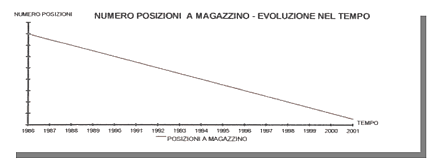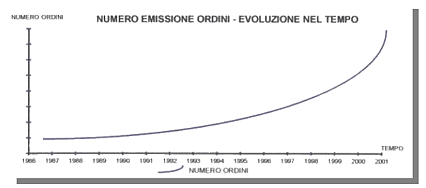According to they give to you currently available, through the integrated supply is
possible to estimate one reduction of the paper members around 90%.
In particular, an enterprise customer
of Unitec in the first 16 months in which supplyings they have been managed through the integrated supply, has reduced
the number of bubbles from 1321 to 85, with an equal reduction to the 93,56%, and the number of invoices from 1000 to 40,
with an equal reduction to the 96,00%. Reassuming we can say that the direct costs cut to you regard:
- The field acquires: thanks to the unification and to graduate them reduction of the demands and the orders, the
prompt ones, of the translations, etc;
- The administrative field: in consequence to being able to manage a single
invoice that only more positions and more suppliers fine eventually to the carriers, and to thus carry out a single
payment to a single supplier (the procurement-provider).
- The logistic field: a single bubble of delivery, reduces
and simplifies the acceptance of the goodses.
- The recording: the reduction of the number of the transactions (your paper
supports) involves an enormous decrease of the physical volume of the recordings and consequently it renders the access
to documents simpler and precise.
Moreover ulterior optimizations are generated, indirectly,: it comes reduced the
use of the telephone and of all the mass media it is inner to the company is towards the outside; they come optimizes
the investments to you of the resources towards Core business; it improves the effectiveness of the organizational
structure; they improve the logistic flows through a better synergy with the carriers that deliver the goods.
Of particular interest they are also turns out you to the management of the warehouse in the time.
The consequence of the esternalizzazione of supplyings positively on the indices of spin of the stock goods:
being able to reperire the goods in instantaneous way, it is possible to reduce the amount of supplyes is of the strategic
assets, that of the not strategic assets that they are present in warehouse for eventually being able to be used to
taking place itself of not expectable situations (like unexpected peaks of production or breakdowns to the systems)
and that in the time they can be revealed unusable in how much obsolete or deperite.
Such concept graphically is
represented in the Fig. 3.6, 3,7 here of continuation brought back.

Fig. 3.6: Course of the amount of goods in the warehouse of an enterprise that uses the service of integrated supply.

Fig. 3.7: Course of the emission of the orders of supply integrated in the same period of time.
In Fig. 3.7 the course of the amount of goods held in warehouse is brought back, than like it can be
observed as a result of the adoption of the supply integrated with passing of the years becomes more and more low,
nearly to become null.
In Fig. 3,8 instead the course of the number of emissions of orders is indicated, than with
passing they become more and more numerous, but the material amount becomes always greater.

Fig. 3.8: Relation between number
of supplyes in the warehouse and amount of the orders of integrated supply.
In diagram 3.8, over brought back the accent comes place on the relation in the time that exists between the number of
orders carries out with the integrated supply and the supplyes to you of warehouse; it is obvious that much more it is
rerun to the integrated supply, the many more stock goodses stretch to diminish.
Naturally the service of integrated
supply comes "personalized" from Unitec based on requirements of the own customers, as an example agreeing the frequency
of the arrivals of the goods, or the frequencies and the modalities of payment, or still selecting the suppliers near
which Unitec will be able to address.



